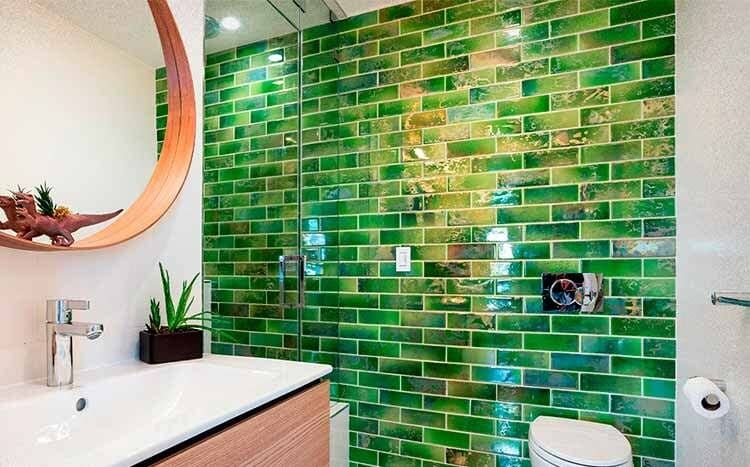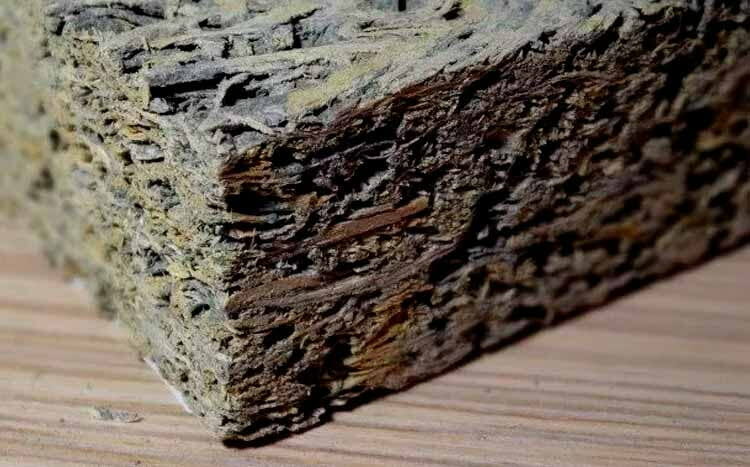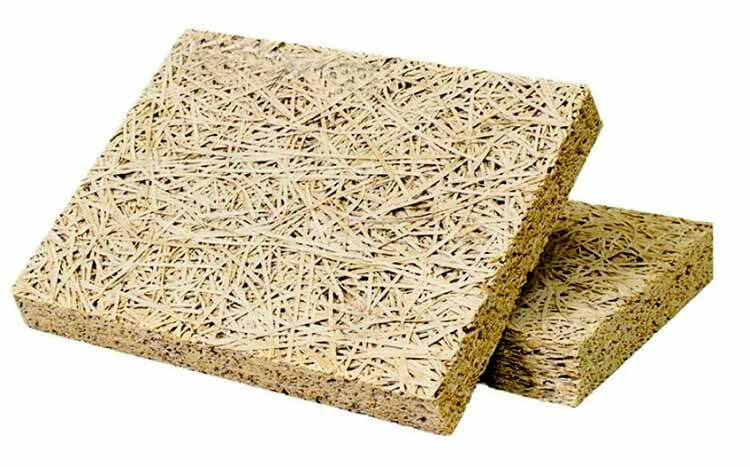Understanding the various kinds of drywall and their specific applications in the home is crucial. Greenboard represents a distinct category of drywall, perfect for high-moisture environments like bathrooms. Although it is constructed from the basic elements of traditional drywall, it features a gypsum core. Moreover, Greenboard is enhanced with additional ingredients that improve its moisture resistance.
You can not install greenboard in a shower or other wet areas within the bathroom because water contact can ruin it. Greenboard is NOT designed to be waterproof, but its excellent moisture-resistant qualities make it a suitable option for use in damp spots in bathrooms.
The recent trend of using paperless cement boards as a tile backer in shower stalls has reduced the demand for greenboard in bathroom construction.

What is Greenboard?
Greenboard is a drywall type that homeowners use for covering walls in damp or humid areas within the home interior. Although, it is commonly regarded as waterproof. Greenboard has no waterproof or water-resistant capabilities. And professionals do not recommend installing greenboard in areas with high water contact levels, such as shower stalls or bathtub walls.
Green board is practically the same as gypsum drywall, but with additional wax coating and other enhancements providing better moisture resistance than standard drywall. It derives its name from the green exterior paper covering one side of greenboard sheets. The green paper is not moisture resistant, but it acts as a guide to help installers know which side to apply joint compound.
A significant advantage of greenboard is easy to install and has lower installation costs than other moisture-resistant tile backer boards, e.g., cement boards. Greenboard is also easier to install, making it the ideal construction material for DIY projects.
Use this FREE service
HomeGardenGuides.com is a free service that quickly matches you with top-voted local drywall contractors.
You can get three estimates fast by real certified experts in your area in just 2 minutes.
- Scroll to the top of the page and enter your Zip code.
- Answer questions about your drywall job
- Your project details are forwarded to three local experts. They will send you a price estimate for the job and some friendly advice.
IMPORTANT: There is no obligation to hire. This is a free tool and service to be used at your pleasure.
Can you install greenboard on bathroom ceilings?
Some building codes do not allow the installation of greenboard on bathroom ceilings due to their weight and high moisture absorption rate. Greenboard ceilings in bathrooms can sag or fall, and several professionals do not recommend them for bathroom ceilings.
A significant number of greenboard bathroom ceilings fail due to the collection of moisture and steam from showers and hot baths. The excess moisture buildup weakens the greenboard structure making it lose rigidity and eventually sag. However, the issues outlined above do not mean you can not install a greenboard ceiling for your bathroom.
Attaching the greenboard to your bathroom ceiling frames every 12 inches instead of the usual 16 inches to prevent sagging will result in a more secure and durable greenboard ceiling that functions appropriately. To achieve this, you will need to modify your ceiling joists by installing 1inch by 3-inch lumber perpendicular to the existing ceiling joists
An important tip is to use lots of screws when attaching the greenboard. But avoid driving the screws completely through the greenboard to retain the integrity of the structure. You can use lots of screws
Things to know before using greenboard in the bathroom
Homeowners wishing to install greenboard in the bathroom are often unaware of its capabilities and limitations. We will discuss a few of the most common greenboard misconceptions and touch on a few characteristics of greenboard.
- Greenboard is lighter than conventional drywall.
No, greenboard is not lighter than drywall. Standard drywall thickness is ¼ inch, while greenboard is produced in ½ and ⅝ inch thickness. The extra thickness is due to the additional wax needed to make greenboard waterproof. You’ll need a strong pair of hands to haul the greenboard into place during installation because of the extra weight. - Greenboard Is waterproof.
It is not true that greenboard is waterproof. Greenboard isn’t rated for use in wet environments or spots where there is water contact. However, it is designed to resist moisture and has superior properties that make greenboard than standard drywall. - Greenboard Is Not Fire Resistant.
Greenboard does not have a fire rating. And as such, you can not install it for fire safety purposes. Fire-resistant drywall such as ⅝ inch thick Type X drywall has a high fire rating and are excellent construction materials suitable for use around fire risk areas, like fireplaces and around furnaces. - You need special tools to install greenboard
Installing greenboard does not require any special tools or skills. Anyone who has experience hanging drywall can install greenboard using the same tools and technique. But the screws attaching the greenboard to the bathroom wall must undergo anti-corrosion treatment to prevent rust due to the higher moisture content in the installation areas.
Greenboard alternatives for showers
Tile backer boards for showers need to be durable enough to resist water damage which causes rot, swelling, and delamination in drywall-based tile backer boards, including greenboard. The development of Cementitous Backer Units CBU, otherwise known as cement boards by drywall producers such as Durock and Hardiebacker, has primarily replaced drywall in wet bathroom areas.
Cement boards are highly durable waterproof and moisture resistant tile backer boards providing superior performance than greenboard in areas with high water contact. Cement boards are made from inorganic materials impervious to water damage which prevents further damage to the internal wall frames.

Greenboard vs. cement board
Cement boards are fast replacing greenboard as the ultimate tile backer board for bathrooms. While many people consider cement boards as a superior product over greenboards, many others are not quite certain whether installing cement boards offers any extra benefits. So, we take a moment to compare both materials to see which one will come out on top as the better product.
| Greenboard | Cement Board |
|---|---|
| It is an affordable and easy-to-install alternative to cement board. Greenboard does not require you to put up a moisture barrier before installing. | A cement board requires a moisture barrier in bathroom applications, adding to installation costs. Making it a more expensive option all-round. |
| Greenboard components consist of gypsum pressed between two sheets of thick paper, one side covered in green moisture-resistant paper. | The main ingredients used in the production of cement boards are cement and glass fibers. |
| Greenboard is available in different sizes and thicknesses. Namely; 4×8 foot and 4×10-foot sheets with thickness ranging between ½ inch or ⅝ inch. | Manufacturers produce cement board in 4×8-foot and 3×5-foot sheets with thickness between ½ inch and ¼ inch. |
| Greenboard is lighter and less durable than cement board. Greenboard has low impact resistance, and it is only recommended for indoor applications. | Clement boards are a more durable material than greenboard. It is heavier and has more impact resistance which makes it a suitable material for both indoor and outdoor applications. |
| Greenboard is neither waterproof nor water-resistant. M | Cement boards are produced in waterproof and water-resistant versions. Manufacturers add layers of wax to greenboard sheets to make them moisture-resistant. |
| Greenboard can be installed as a DIY project without much difficulty. | Installing cement boards as a DIY project can be difficult for homeowners with minimal skills and experience. |
| Greenboards are not a suitable material for tile backing boards in wet areas. | Cement board is an excellent underlying material for tile backers in wet areas with lots of water contact. |
HOW TO INSTALL GREEN BOARD
Greenboard installation process is similar to drywall installation in many respects. But unlike drywall, you need hot-galvanized hanging screws instead of standard drywall screws because of corrosion issues.
Here is a breakdown of the installation process.
Step 1.
- Prepare the area you want to cover with the greenboard panels.
- Examine and carefully measure the spot.
- Trace and cut out areas with complex shapes on a piece of paper for transfer on a greenboard.
Step 2.
- Score the greenboard surface with a utility knife.
- After cutting through the first paper layer, snap the board apart and straight edge it with a sharp blade.
- Use a drywall or saber saw to create curved and round cuts in the drywall where necessary.
Step 3
- Cover the narrow space between the boards with joint compound. Lay a thin layer of joint compound to overlap the seam separating both boards by two inches.
- Place a strip of fiberglass mesh tape over the seam.
- Using a blade, cover the tape with drywall compound and set it into the joint compound firmly.
- Smoothen the tape and joint compound application with a broader blade and feather the edges like you do on a typical drywall installation.
Step 4
- Hang the greenbaord to wall studs with anti-corrosive screws.
Avoid driving the screws completely through the greenboard. - Fill the dents created by the nails with the joint compound and cover the screw heads.
Step 5
- Apply water-resistant paint over the greenboard after installation is complete.
- Avoid installing ceramic tiles directly over the greenboard to prevent moisture penetration and deterioration.
Can you use drywall instead of greenboard in the bathroom?
You can not use traditional drywall instead of greenboard in bathrooms because conventional drywall lacks the moisture resistance qualities of greenboard. Although, both materials share the same gypsum core. Greenboard is designed explicitly for moist or humid applications, while drywall is designed for dry areas.
The characteristics distinguishing greenboard from standard drywall include:
- Greenboard has an outer green colored paper covering, but drywall does not.
- Certain types of greenboard are treated with compounds that inhibit mold growth.
- Greenboard sheets are thicker than drywall to compensate for the loss of rigidity when wet.
- The green-colored outer paper on greenboard sheets is not moisture-resistant. Its purpose is to specify greenboard sheets as a moisture-resistant drywall type and help you determine where to apply the joint compound during installation.
Should you DIY or hire a professional to install a greenboard in your shower?
Hiring a professional to install greenbaord in a shower stall can be an excellent idea if you can afford the expenses. The average cost of having a professional install greenboard as a tile backer board is $1.25 per square foot and can range between $1.05 to $1.45. An advantage of hiring a professional is the guarantee of a higher quality job. And the assurance of minimal post-installation issues.
A homeowner with minimal skills can easily install greenboard sheets. The installation process is akin to hanging drywall, so it is easy to get the hang of it in no time. While DIY installation is prone to errors, some of which can be expensive. Homeowners can quickly correct the mistakes and change
Tools for installing greenboard
You can use standard drywall tools to install greenboard because both materials share similar structural composition and a gypsum inner core. Most DIYers can source the necessary tools and materials from local hardware stores.
List of tools and materials include.
- Drywall knife.
- Drywall tape.
- Hammer.
- Measuring tape.
- Saber saw.
- Putty knife.
- Joint compound.
- Galvanized screws.
- Screwdriver
FAQ's
No, standard drywall is not designed for use in wet areas like shower stalls. Using regular drywall as tile backer boards for your shower area can lead to drywall damage which can also affect the wall frame.
Greenboard has lower moisture resistance than cement board. The cement board is waterproof, while greenboard only has minimal water resistance capability. For this reason, you can only use greenboard in areas with lower humidity and moisture levels, while you can install cement boards on walls in wet areas.








